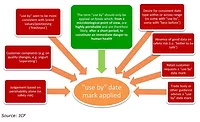Half of EU Adults Do Not Check Use-By Date Before Consuming Food

A survey of adults in England, Wales, and Northern Ireland showed that half do not always check the use-by date on food before eating it.
At least 44 percent view use-by dates as a "useful guide," and half of adults surveyed could not identify the correct definition for a use-by date. Use-by dates relate to safety and can be found on meat and ready-to-eat salads. A "best-before" date relates to quality and appears on frozen, dried, and canned foods.
The survey also showed that 76 percent of adults have knowingly eaten food past the use-by date, with 37 percent cooking food for other people that is after this date. This rises to 43 percent of people for people ages 25 to 34 years old.
The online poll by Ipsos Mori was based on 2,132 respondents, ages 16 to 75, in England, Wales, and Northern Ireland between March 5–8, 2021.
More than three-quarters of people decide whether food is safe to eat by smelling it; however, food safety professionals advise against using smell or appearance in determining whether food is safe to eat.
According to EU requirements, food labeling must meet certain requirements. It has to be in language that is easy for consumers to understand and, if required, in several languages. Legislation in the EU requires that food products indicate either the date of minimum durability (“best before” date) or the “use by” date.
Looking for quick answers on food safety topics?
Try Ask FSM, our new smart AI search tool.
Ask FSM →








